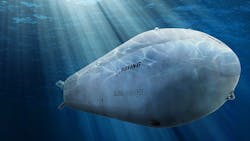Navy asks Boeing to find new missions, payloads, and capabilities for long-endurance extra-large UUV
WASHINGTON – Undersea warfare experts at the Boeing Co. will develop additional capabilities, payloads, operational uses, and deployment scenarios for a new class of extra-large unmanned underwater vehicles (UUVs) with the potential to undertake long-endurance missions to deploy sensors or other UUVs.
Officials of the U.S. Naval Sea Systems Command in Washington announced a $10.8 million contract modification to the Boeing Defense, Space & Security segment in Huntington Beach, Calif., on Tuesday for engineering services in support of the Extra Large Unmanned Undersea Vehicle (XLUUV) program.
Extra-large UUVs typically are autonomous mini-submarines that measure about seven feet in diameter -- sometimes larger. They are designed for launch from shore or from large military ships with well decks, or from large civil vessels with moon pools.
Boeing is developing the modular-construction Orca XLUUV to be an open-architecture reconfigurable UUV with the core vehicle providing guidance and control, navigation, autonomy, situational awareness, core communications, power distribution, energy and power, propulsion and maneuvering, and mission sensors, Navy officials say.
The Orca XLUUV will have well-defined interfaces for cost-effective future upgrades to capitalize on advances in technology and respond to threat changes. The Orca XLUUV will have a modular payload bay, with defined interfaces to support current and future UUV payloads.
XLUUVs, which are among the largest unmanned submersibles ever conceived, will be for long-endurance surveillance missions or undersea cargo vessels to deliver other sensor payloads and other UUVs.
These large unmanned undersea vehicles eventually could be used as motherships to deploy and recover smaller surveillance UUVs on far-flung reconnaissance, surveillance, or special warfare missions in the open ocean or along coastlines and inside harbors.
The Navy and the U.S. Defense Advanced Research Projects Agency (DARPA) in Arlington, Va., have involved Lockheed Martin and Boeing on a variety of large UUV projects such as the Large-Displacement Unmanned Underwater Vehicle (LDUUV) project.
An LDUUV typically is described as an autonomous submarine no larger than 80 inches in diameter. Future XLUUVs likely will be larger. Experience with the LDUUV will help inform concepts for using XLUUV.
DARPA issued a solicitation two years ago for the Hunter program to develop a payload-delivery system from an extra-large UUV. The Hunter program, however, involves only the payload delivery system and not the extra-large UUV itself.
Hunter payloads could involve persistent-surveillance sensors, weapons, or other unmanned underwater vehicles (UUVs) and unmanned aerial vehicles (UAVs). They could involve persistent-surveillance sensors, weapons, or other UUVs and perhaps even unmanned aerial vehicles (UAVs).
The Navy's XLUUV project is moving enabling technologies forward that were developed originally in other projects such as the DARPA Hydra program to develop an unmanned submersible large enough to transport and deploy UAVs and UUVs stealthily in enemy territory to respond quickly to situations around the world.
Boeing has developed the Echo Voyager, a 51-foot large UUV that can reach depths of 11,000 feet and can operate independently for months underwater. Boeing unveiled the Echo Voyager in early 2016 and began sea trials of the unmanned undersea craft in summer 2017.
On this contract modification Boeing will do the work in Huntington Beach, Calif., and should be finished by September 2020. For more information contact Boeing Defense, Space & Security online at www.boeing.com/defense/autonomous-systems/echo-voyager/index.page, or Naval Sea Systems Command at www.navsea.navy.mil.

John Keller | Editor-in-Chief
John Keller is the Editor-in-Chief, Military & Aerospace Electronics Magazine--provides extensive coverage and analysis of enabling electronics and optoelectronic technologies in military, space and commercial aviation applications. John has been a member of the Military & Aerospace Electronics staff since 1989 and chief editor since 1995.

